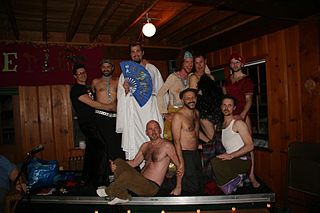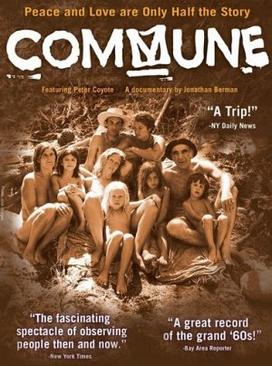
A hippie, also spelled hippy, especially in British English, is someone associated with the counterculture of the 1960s, originally a youth movement that began in the United States during or around 1964 and spread to different countries around the world. The word hippie came from hipster and was used to describe beatniks who moved into New York City's Greenwich Village, in San Francisco's Haight-Ashbury district, and Chicago's Old Town community. The term hippie was used in print by San Francisco writer Michael Fallon, helping popularize use of the term in the media, although the tag was seen elsewhere earlier.

Gridley is a city in Butte County, California, United States, 29 miles south of Chico, California and 56 miles north of Sacramento, California. The population as of April 1, 2020 is 7,421. California State Route 99 runs through Gridley and Interstate 5 and California State Route 70 are both nearby.

A counterculture is a culture whose values and norms of behavior differ substantially from those of mainstream society, sometimes diametrically opposed to mainstream cultural mores. A countercultural movement expresses the ethos and aspirations of a specific population during a well-defined era. When oppositional forces reach critical mass, countercultures can trigger dramatic cultural changes. Prominent examples of countercultures in the Western world include the Levellers (1645–1650), Bohemianism (1850–1910), the more fragmentary counterculture of the Beat Generation (1944–1964), and the globalized counterculture of the 1960s (1965–1973). Countercultures differ from subcultures.

The Radical Faeries are a loosely affiliated worldwide network and countercultural movement seeking to redefine queer consciousness through secular spirituality. Sometimes deemed a form of modern Paganism, the movement also adopts elements from anarchism and environmentalism.

An intentional community is a voluntary residential community which is designed to have a high degree of social cohesion and teamwork. The members of an intentional community typically hold a common social, political, religious, or spiritual vision, and typically share responsibilities and property. This way of life is sometimes characterized as an "alternative lifestyle". Intentional communities can be seen as social experiments or communal experiments. The multitude of intentional communities includes collective households, cohousing communities, coliving, ecovillages, monasteries, survivalist retreats, kibbutzim, hutterites, ashrams, and housing cooperatives.
Patrick Califia is an American writer of non-fiction essays about sexuality and of erotic fiction and poetry. Califia is a bisexual trans man. Prior to transitioning, Califia identified as a lesbian and wrote for many years a sex advice column for the gay men's leather magazine Drummer. His writings explore sexuality and gender identity, and have included lesbian erotica and works about BDSM subculture. Califia is a member of the third-wave feminism movement.

The White Panthers were an anti-racist political collective founded in November 1968 by Pun Plamondon, Leni Sinclair, and John Sinclair. It was started in response to an interview where Huey P. Newton, co-founder of the Black Panther Party, was asked what white people could do to support the Black Panthers. Newton replied that they could form a White Panther Party. The counterculture era group took the name and dedicated its energies to "cultural revolution.” John Sinclair made every effort to ensure that the White Panthers were not mistaken for a white supremacist group, responding to such claims with "quite the contrary." The party worked with many ethnic minority rights groups in the Rainbow Coalition.

The black power movement or black liberation movement was a branch or counterculture within the civil rights movement of the United States, reacting against its more moderate, mainstream, or incremental tendencies and motivated by a desire for safety and self-sufficiency that was not available inside redlined African American neighborhoods. Black power activists founded black-owned bookstores, food cooperatives, farms, media, printing presses, schools, clinics and ambulance services.

The Love Family, or the Church of Jesus Christ at Armageddon, was a U.S. communal religious movement formed in 1968 and led by Paul Erdmann, who renamed himself Love Israel.

The counterculture of the 1960s was an anti-establishment cultural phenomenon and political movement that developed in the Western world during the mid-20th century. It began in the early 1960s, and continued through the early 1970s. It is often synonymous with cultural liberalism and with the various social changes of the decade. The effects of the movement have been ongoing to the present day. The aggregate movement gained momentum as the civil rights movement in the United States had made significant progress, such as the Voting Rights Act of 1965, and with the intensification of the Vietnam War that same year, it became revolutionary to some. As the movement progressed, widespread social tensions also developed concerning other issues, and tended to flow along generational lines regarding respect for the individual, human sexuality, women's rights, traditional modes of authority, rights of people of color, end of racial segregation, experimentation with psychoactive drugs, and differing interpretations of the American Dream. Many key movements related to these issues were born or advanced within the counterculture of the 1960s.
Morningstar Commune was an active open land counterculture commune in rural Sonoma County, California, located at 12542 Graton Road near Occidental.

Commune is a 2005 documentary film by Jonathan Berman. The film is about an intentional community located in Siskiyou County, California called Black Bear Ranch and features narration by Peter Coyote who himself once resided at Black Bear.
The hippie subculture began its development as a youth movement in the United States during the early 1960s and then developed around the world.

Akinyele Umoja is an American educator and author who specializes in African-American studies. As an activist, he is a founding member of the New Afrikan People's Organization and the Malcolm X Grassroots Movement. In April 2013, New York University Press published Umoja's book We Will Shoot Back: Armed Resistance in the Mississippi Freedom Movement. Currently, he is a Professor and Department Chair of the Department of African-American Studies at Georgia State University (GSU).
The San Diego Free Press was an underground newspaper founded by philosophy students of Herbert Marcuse at the University of California, San Diego in November 1968, and published under that title biweekly until December 1969, when it became the weekly Street Journal starting with its 29th issue. The paper's contents were a mix of radical politics, alternative lifestyles, and the counterculture, reflecting in part Marcuse's Frankfurt School Marxist/Freudian ideas of cultural transformation.
The New Left was a broad political movement that emerged from the counterculture of the 1960s and continued through the 1970s. It consisted of activists in the Western world who campaigned for a broad range of social issues such as feminism, gay rights, drug policy reforms, Statism, Neo-Marxism and the rejection of traditional family values, social order, and gender roles. The New Left differs from the traditional left, in that it tends to lean more in favor of social justice compared to previous eras. However, others have used the term "New Left" to describe an evolution, continuation, and revitalization of traditional leftist goals.

The Friends of Perfection Commune is an American Utopian community in San Francisco, California. The commune was founded in 1967 on principles of a common treasury, group marriage, free anonymous art, gay liberation, and selfless service. They were originally called the Sutter/Scott Street commune, and commonly referred to as the Kaliflower commune, after their newsletter of the same name. Because the commune's publishing activities helped spread their philosophy, they became a significant influence on Bay Area culture. Many members of The Angels of Light, a free psychedelic drag theater group, originally lived in the Kaliflower commune. The name Kaliflower referenced the Hindu name for the last and most violent age of humankind, the Kali Yuga.
Shivalila was a commune founded in Bakersfield, California, in the 1970s by Gridley Lorimer Wright IV (1934-1979). They believed if a child was not dependent on just its mother, but instead had a healthy relationship with many mothers, a more secure mode of attachment would be created, which would birth a new consciousness model for humanity...this information is from the 'Book of the Mother' The New York Sun describes them as a "nomadic cult of acid-taking, baby-worshiping hippies looking for the perfect place to bring up children.
Jonathan Berman is an American film producer, director, screenwriter, and academic. He is best known for his documentary work as producer and film director of The Shvitz (1993), My Friend Paul (1999), Commune (2005), and Calling All Earthlings (2018). His non-fiction feature films explore subculture and identity, depicting how alternative people, groups and ideas are represented in media. Berman currently serves as a professor at California State University San Marcos.













